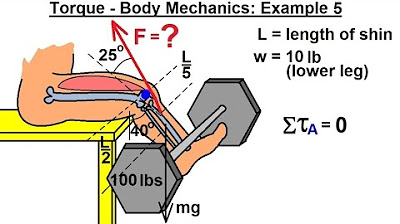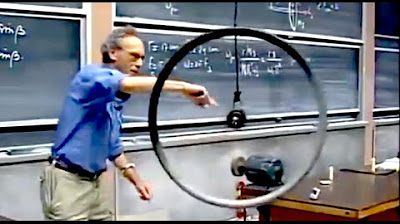Anti-Gravity Wheel?
TLDRIn a remarkable demonstration at the University of Sydney, a forty-pound flywheel attached to a meter-long shaft is shown to defy gravity when spun at high speeds. The presenter, initially struggling to lift the stationary wheel, effortlessly raises it overhead once spinning, illustrating the principles of gyroscopic precession. The experiment further explores the effect by measuring the presenter's weight with and without the spinning flywheel, challenging viewers to predict the scale's reading during the lift.
Takeaways
- 🏋️♂️ The demonstration involves a forty-pound (nineteen-kilogram) flywheel on a meter-long shaft.
- 🤔 Holding the flywheel horizontally with one hand at rest is virtually impossible due to its weight.
- 💫 When the flywheel is spun to a few thousand RPM, it can be held horizontally from one end without difficulty.
- 🔄 The phenomenon at play is gyroscopic precession, which counteracts the expected pull of the wheel towards the ground.
- 👨🔬 The presenter attempts to lift the spinning flywheel over their head with one hand, showcasing its seemingly weightless feel.
- 🏋️♀️ The presenter initially struggles to lift the flywheel without it spinning, highlighting the difference in effort required when it's not in motion.
- 📈 A scale reading experiment is proposed to measure the apparent weight change when lifting the spinning flywheel.
- 🔢 The scale reading with the flywheel at rest is 72 kilograms, increasing to 91 kilograms when the flywheel is lifted.
- 🤷♂️ The presenter challenges the viewer to predict the scale reading while lifting the spinning flywheel over their head.
- 🎥 A video on gyroscopic precession is mentioned for a more detailed explanation of the phenomenon.
- 🙏 The presenter's experience of lifting the spinning flywheel feels effortless, contrary to the actual weight of the object.
Q & A
What is the weight and size of the flywheel mentioned in the transcript?
-The flywheel weighs forty pounds or nineteen kilograms and is on the end of a meter-long shaft.
Why is it difficult to hold the flywheel horizontally without spinning it?
-Holding the flywheel horizontally without spinning it is difficult because of its significant weight and the leverage created by its length, making it almost impossible to hold with one hand.
What happens when the flywheel is spun up to a few thousand RPM and then held horizontally?
-When the flywheel is spun up to a few thousand RPM and held horizontally, the shaft remains horizontal and the wheel appears almost weightless due to the effect of gyroscopic precession.
What is gyroscopic precession and how does it apply to the flywheel demonstration?
-Gyroscopic precession is a phenomenon where the rotation of a spinning body resists any change in its orientation. In the flywheel demonstration, the precession counteracts the force of gravity, making the wheel seem weightless when spun at high speeds.
What does the speaker attempt to do after spinning the flywheel?
-The speaker attempts to lift the spinning flywheel over their head using only one hand while it is spinning.
Why does the speaker struggle to lift the flywheel above their head without it spinning?
-The speaker struggles to lift the flywheel above their head without it spinning because the full weight of the flywheel, without the counteracting effect of gyroscopic precession, is difficult to manage with one hand.
How does the speaker ensure the flywheel is spinning fast enough for their attempt?
-The speaker ensures the flywheel is spinning fast enough by giving it ten more seconds to spin up before attempting to lift it over their head.
What is the result of the speaker's attempt to lift the spinning flywheel over their head?
-The speaker successfully lifts the spinning flywheel over their head, describing the sensation as incredibly light due to the effects of gyroscopic precession.
What experiment is suggested to further demonstrate the effects of lifting the spinning flywheel?
-The suggested experiment is for the speaker to stand on a scale while lifting the spinning flywheel over their head to measure any changes in weight, essentially to see if the speaker gets lighter during the lift.
What is the initial weight measured on the scale with just the speaker?
-The initial weight measured on the scale with just the speaker is about 72 kilograms.
How does the scale reading change when the speaker picks up the non-spinning flywheel?
-When the speaker picks up the non-spinning flywheel, the scale reading goes up to about 91 kilograms, accounting for the weight of the flywheel.
What prediction is being asked of the viewer regarding the scale reading while the speaker lifts the spinning flywheel over their head?
-The viewers are asked to predict whether the scale reading will be more, less than, or equal to 91 kilograms when the speaker lifts the spinning flywheel over their head.
Outlines
🏋️♂️ The Challenge of Lifting a Spinning Flywheel
In this segment, the presenter is at the University of Sydney, where a mechanical engineering shop has constructed a unique apparatus for demonstration. The apparatus consists of a forty-pound (nineteen-kilogram) flywheel attached to a meter-long shaft. The presenter humorously attempts to hold the flywheel horizontally by one end, highlighting the difficulty of the task due to its weight. The demonstration then moves on to spinning the flywheel at high speeds (a few thousand RPM) and releasing it, showing that the flywheel remains horizontal due to gyroscopic precession. The presenter further challenges the phenomenon by attempting to lift the spinning flywheel over his head with one hand, emphasizing the surprising ease of the task despite the flywheel's considerable weight. The segment concludes with an experiment to measure the apparent weight of the presenter and the flywheel using a scale, with the flywheel adding about 19 kilograms to his weight when not spinning, and a prediction is made about the scale's reading while he lifts the spinning flywheel overhead.
📈 The Scale Experiment: Perception vs. Reality
This paragraph presents an interactive element where the audience is invited to predict the outcome of an experiment involving the scale reading while the presenter lifts the spinning flywheel over his head. The question posed is whether the scale will show a reading more, less, or equal to 91 kilograms, which is the combined weight of the presenter and the flywheel at rest. The audience can make their predictions through on-screen annotations or a link in the video description. The segment ends with a countdown, building anticipation for the experiment's result.
Mindmap
Keywords
💡flywheel
💡torque
💡gyroscopic precession
💡RPM (Revolutions Per Minute)
💡weightlessness
💡shaft
💡scale
💡lifting
💡precession
💡mechanical engineering
💡University of Sydney
Highlights
The University of Sydney's mechanical engineering shop built an impressive apparatus.
The apparatus consists of a 40-pound (19 kg) flywheel on a meter-long shaft.
Holding the apparatus horizontally with one hand at the end is virtually impossible.
Spinning the flywheel up to a few thousand RPM allows it to be held horizontally from one end.
The spinning flywheel appears almost weightless due to gyroscopic precession.
A detailed explanation of gyroscopic precession is provided in a linked video.
An attempt to lift the spinning flywheel over the head with one hand is successful.
Lifting the flywheel above the head without spinning is challenging.
The spinning flywheel feels incredibly light when lifted over the head.
The experimenter's lack of strength does not hinder the lifting of the spinning flywheel.
The flywheel's spinning motion seems to assist in lifting it upwards.
The scale reading increases from 72 kg to 91 kg when the flywheel is lifted.
The flywheel adds approximately 19 kg to the total weight.
A prediction is made on whether the scale reading will change when lifting the flywheel over the head.
The experiment demonstrates the counterintuitive effects of gyroscopic precession on weight perception.
The experiment is a practical application of theoretical physics principles.
The apparatus and experiment showcase the power of mechanical engineering.
Transcripts
Browse More Related Video

Wheel momentum Walter Lewin

Gyroscopic Precession is Easier Than You Think!

Physics 15 Torque (17 of 25) Body Mechanics: Ex. 5, F=? Leg Lifting Weights

The Mind-Bending Physics that Give Tennis Pros Their Edge

8.01x - Lect 24 - Rolling Motion, Gyroscopes, VERY NON-INTUITIVE

Most People Don't Know How Bikes Work
5.0 / 5 (0 votes)
Thanks for rating: